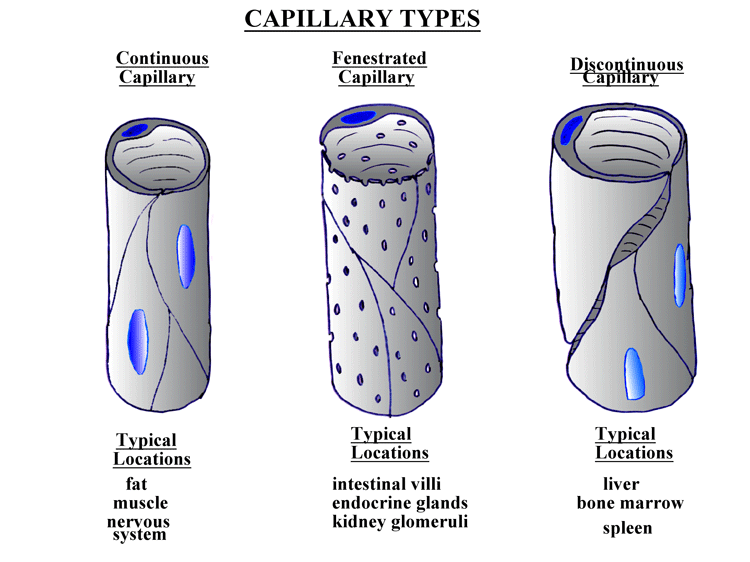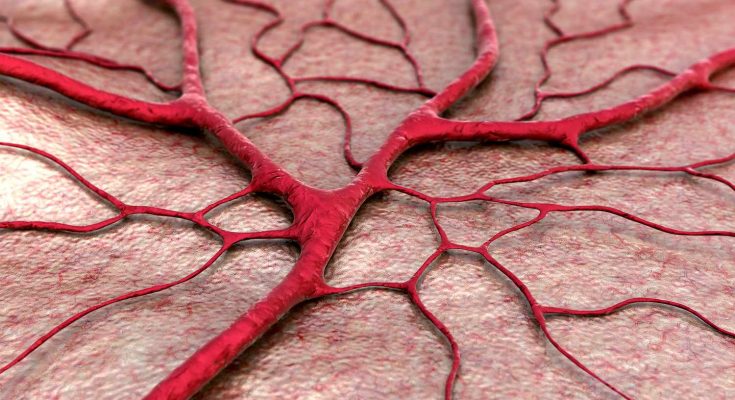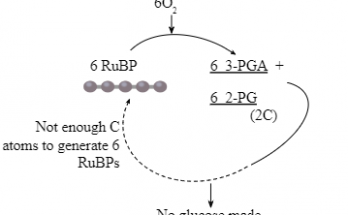Table of Contents
Capillaries – Definition
Capillaries are tiny blood vessels that connect Arterioles (small arteries) and Venules (small veins) in the Circulatory System. They are the smallest and most numerous blood vessels in the body, with a diameter of only a few micrometers.
Capillaries have a crucial role in the exchange of gasses, nutrients and waste products between the blood and surrounding tissues. They are found in all tissues and organs of the body and their density varies depending on the metabolic activity of the tissue.
Capillaries are composed of a single layer of endothelial cells which allows for efficient exchange between the blood and the surrounding tissues.
Also Check – 8 Structural and Functional Difference Between Arteries Veins and Capillaries
Capillaries – Location
Capillaries are located throughout the body, connecting Arterioles and Venules. They are found in all tissues and organs, and their density varies depending on the metabolic activity of the tissue. For example, organs with high metabolic activity, such as the heart and brain, have a higher density of Capillaries than other organs.
Capillaries – Structure
Capillaries are the smallest blood vessels in the body, with a diameter of only a few micrometers. They are composed of a single layer of endothelial cells. Endothelial cells are flattened cells that line the interior surface of the vessel. This single layer allows for efficient exchange of gasses and nutrients between the blood and surrounding tissues.
Capillaries are also surrounded by a basement membrane, which provides support and allows for the exchange of molecules. In some tissues such as the liver, Capillaries are lined with specialized cells called Kupffer cells, which play a role in the immune response.
Capillaries can be classified into three types based on their structure –
- Continuous Capillaries
- Fenestrated Capillaries
- Sinusoidal Capillaries

Continuous Capillaries
Continuous Capillaries are the most common type and are found in most tissues. They have a continuous endothelial lining with tight junctions that limit the passage of large molecules and cells. These Capillaries are found in the skin, muscles, and lungs.
Fenestrated Capillaries
Fenestrated Capillaries have small pores in their endothelial lining that allow for the passage of small molecules and ions. These Capillaries are found in the kidneys, endocrine glands, and small intestine.
Sinusoidal Capillaries
Sinusoidal Capillaries have large gaps between their endothelial cells, allowing for the passage of large molecules and cells. These Capillaries are found in the liver, spleen and bone marrow.
Function and Importance of Capillaries

- Oxygen and nutrient exchange– Capillaries are responsible for the exchange of oxygen and nutrients from the bloodstream to the body’s tissues. This exchange is critical to the survival of cells and organs, as it allows them to receive the energy and nutrients necessary to function properly.
- Waste removal – Capillaries also help remove waste products from the body’s tissues. As blood passes through the Capillaries, it collects waste products such as carbon dioxide and carries them away from the tissues for elimination.
- Regulation of blood pressure– Capillaries help regulate blood pressure by providing a large surface area for the exchange of gases and nutrients. This allows for a gradual decrease in blood pressure as blood moves from the Arteries to the Veins.
- Heat exchange– Capillaries play a role in regulating body temperature by allowing for heat exchange between the blood and the tissues. When the body is too warm, Capillaries dilate to allow more blood flow to the surface of the skin, which helps dissipate heat.
- Immune response– Capillaries play a role in the immune response by allowing white blood cells to move from the blood into the surrounding tissues to fight infections. This is important in helping the body to defend itself against pathogens.
- Hormonal regulation – Capillaries are involved in the distribution of hormones throughout the body. Hormones are released into the blood by glands and travel through the Capillaries to reach their target organs.
- Disease diagnosis and treatment – Capillaries can be examined to diagnose certain diseases, such as diabetes and hypertension. In addition, Capillaries can be targeted by certain medications to treat conditions such as cancer.
Frequently Asked Questions on Capillaries
What are Capillaries and what is their role in the circulatory system?
Capillaries are tiny Blood vessels that connect arterioles and venules in the circulatory system. Their role is to facilitate the exchange of gasses, nutrients and waste products between the Blood and surrounding tissues.
What is the structure of Capillaries?
Capillaries are composed of a single layer of endothelial cells, which are flattened cells that line the interior surface of the vessel. They are also surrounded by a basement membrane that provides support and allows for the exchange of molecules.
Where are Capillaries located in the body and how does their density vary?
Capillaries are found in all tissues and organs of the body. Their density varies depending on the metabolic activity of the tissue, with organs that have high metabolic activity (such as the heart and brain) having a higher density of Capillaries than other organs.
What are the three types of Capillaries and where are they found?
The three types of Capillaries are Continuous Capillaries, Fenestrated Capillaries and Sinusoidal Capillaries. Continuous Capillaries are the most common and are found in most tissues, fenestrated Capillaries are found in the kidneys, endocrine glands and small intestine and sinusoidal Capillaries are found in the liver, spleen and bone marrow.
What are the functions of Capillaries?
Capillaries have several functions, including facilitating oxygen and nutrient exchange, removing waste products, regulating Blood pressure, regulating body temperature, playing a role in the immune response and distributing hormones throughout the body.
How do Capillaries help in oxygen and nutrient exchange?
Capillaries facilitate oxygen and nutrient exchange by allowing these substances to pass through their walls and into surrounding tissues.
What role do Capillaries play in waste removal?
Capillaries help remove waste products from the body’s tissues by collecting waste products such as carbon dioxide as Blood passes through them and carrying them away from the tissues for elimination.
How do Capillaries regulate Blood pressure?
Capillaries help regulate Blood pressure by providing a large surface area for the exchange of gases and nutrients. This allows for a gradual decrease in Blood pressure as Blood moves from the Arteries to the veins.
How do Capillaries help regulate body temperature?
Capillaries play a role in regulating body temperature by allowing for heat exchange between the Blood and the tissues. When the body is too warm, Capillaries dilate to allow more Blood flow to the surface of the skin, which helps dissipate heat.
What is the role of Capillaries in the immune response?
Capillaries play a role in the immune response by allowing white Blood cells to move from the Blood into the surrounding tissues to fight infections. This is important in helping the body to defend itself against pathogens.
How are Capillaries involved in hormonal regulation?
Capillaries are involved in the distribution of hormones throughout the body. Hormones are released into the Blood by glands and travel through the Capillaries to reach their target organs.
How can Capillaries be used in disease diagnosis and treatment?
Capillaries can be examined to diagnose certain diseases, such as diabetes and hypertension. Capillaries can be targeted by certain medications to treat conditions such as cancer.


One Comment on “Capillaries – Definition, Location, Structure, Types, Functions and Importance”